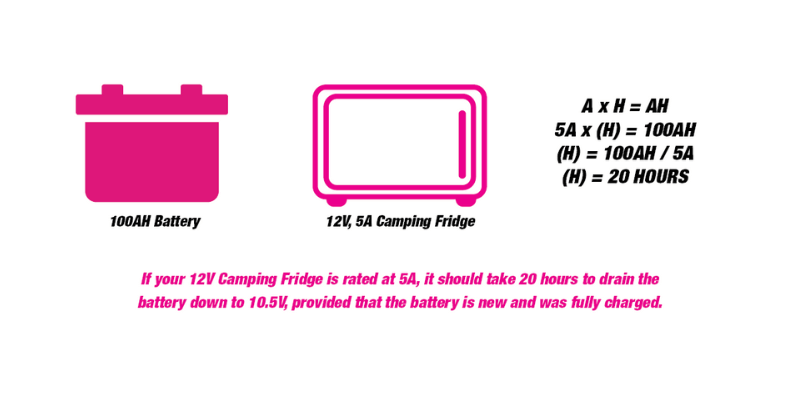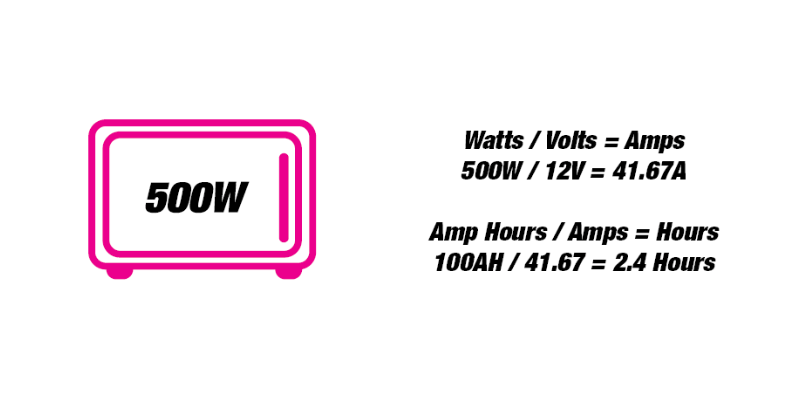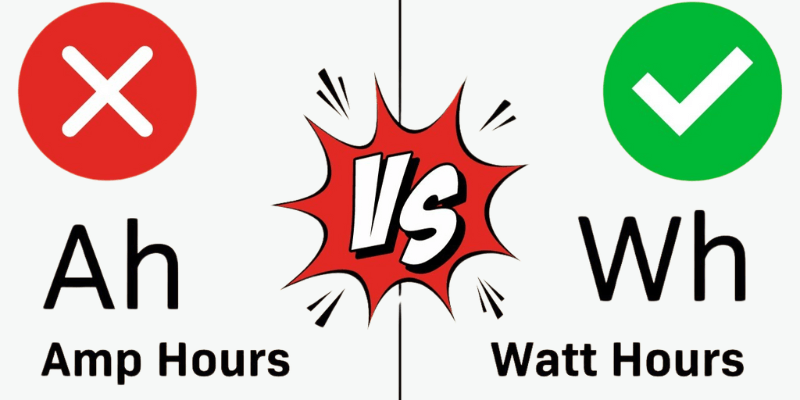ประเด็นสำคัญ:
- แอมป์-ชั่วโมง (Ah) วัดความจุของแบตเตอรี่ในช่วงเวลาหนึ่ง ในขณะที่วัตต์-ชั่วโมง (Wh) บ่งบอกถึงความจุพลังงานทั้งหมด โดยพิจารณาจากกระแสและแรงดันไฟฟ้า
ไม่ว่าคุณจะตั้งค่าระบบพลังงานแสงอาทิตย์ในบ้านหรือเลือกแบตเตอรี่สำหรับยานพาหนะไฟฟ้าของคุณ ก็ต้องอาศัยทักษะเล็กน้อย การทำความเข้าใจแอมป์ชั่วโมง (Ah) และวัตต์ชั่วโมง (Wh) ถือเป็นสิ่งสำคัญในการพิจารณาว่าคุณต้องการพลังงานแบตเตอรี่เท่าใด หากคุณยังใหม่ต่อโลกแห่งแบตเตอรี่ ข้อกำหนดเหล่านี้อาจทำให้สับสน แต่เราพร้อมจะช่วยลดความซับซ้อนให้กับคุณ
ในคำแนะนำที่ไม่ซับซ้อนนี้ เราจะอธิบายความสัมพันธ์ระหว่างชั่วโมงแอมป์กับวัตต์
Amp-Hours คืออะไร และคำนวณอย่างไร
แอมป์-ชั่วโมง มักเขียนว่า Ah เป็นหน่วยประจุไฟฟ้าที่ใช้กันทั่วไปในการวัดความจุของแบตเตอรี่ โดยระบุว่าแบตเตอรี่สามารถส่งประจุไฟฟ้าได้เท่าใดเมื่อเวลาผ่านไป การทำความเข้าใจแอมป์-ชั่วโมงมีประโยชน์ในการพิจารณารันไทม์ของอุปกรณ์ที่ใช้พลังงานจากแบตเตอรี่ และในการเลือกแบตเตอรี่ที่เหมาะสมสำหรับแอปพลิเคชันเฉพาะ
การคำนวณแอมป์-ชั่วโมงเกี่ยวข้องกับการคูณกระแสในหน่วยแอมแปร์ (A) ตามเวลาในหน่วยชั่วโมง (h) ที่กระแสไหล สูตรคำนวณแอมป์-ชั่วโมงคือ:
แอมป์-ชั่วโมง = ปัจจุบัน (เป็นแอมแปร์) x เวลา (เป็นชั่วโมง)
ตัวอย่างเช่น หากอุปกรณ์ดึงกระแสไฟ 1 แอมแปร์และทำงานเป็นเวลา 5 ชั่วโมง การคำนวณจะเป็นดังนี้:
1 แอ x 5 ชม. = 5 อา
ซึ่งหมายความว่าอุปกรณ์จะใช้เวลาชาร์จ 5 แอมป์-ชั่วโมงในระหว่างการใช้งาน

ผู้ผลิตแบตเตอรี่มักระบุความจุของแบตเตอรี่เป็นมิลลิแอมแปร์-ชั่วโมง (mAh) หรือแอมแปร์-ชั่วโมง (Ah) ข้อมูลนี้ช่วยให้ผู้บริโภคเข้าใจว่าแบตเตอรี่สามารถจ่ายไฟให้กับอุปกรณ์ได้นานแค่ไหนก่อนที่จะต้องชาร์จหรือเปลี่ยนใหม่
ทำความเข้าใจเรื่องวัตต์-ชั่วโมง
วัตต์-ชั่วโมงถือเป็นการวัดที่มีประสิทธิภาพที่สุดในการประเมินความจุของแบตเตอรี่เนื่องจากลักษณะที่ครอบคลุม เนื่องจากคำนึงถึงทั้งกระแสและแรงดันไฟฟ้า ทำให้มองเห็นความสามารถของแบตเตอรี่แบบองค์รวมมากขึ้น ความสำคัญของสิ่งเหล่านี้ปรากฏชัดโดยเฉพาะอย่างยิ่งเมื่อเปรียบเทียบแบตเตอรี่ที่มีพิกัดแรงดันไฟฟ้าต่างกัน ด้วยการหาปริมาณพลังงานทั้งหมดที่เก็บไว้ในแบตเตอรี่ วัตต์-ชั่วโมงจะให้ข้อมูลเชิงลึกเกี่ยวกับผลลัพธ์การทำงานที่เป็นไปได้โดยรวมของแบตเตอรี่
วิธีคำนวณวัตต์-ชั่วโมงนั้นง่าย เพียงแต่ต้องรวมกระแสไฟของแบตเตอรี่ซึ่งมีหน่วยเป็นแอมแปร์และแรงดันไฟฟ้าเข้าไว้ในสูตรเฉพาะ สมการที่จะใช้คือ:
ชั่วโมงวัตต์ = ชั่วโมงแอมป์ x แรงดันไฟฟ้า
พิจารณาแบตเตอรี่ที่มีความจุ 10 แอมแปร์ชั่วโมงและแรงดันไฟฟ้า 12 โวลต์ เมื่อใช้สูตรที่กำหนด คุณสามารถคำนวณพลังงานทั้งหมดได้โดยการคูณค่าทั้งสองนี้:
10Ah x 12V = 120 วัตต์ชั่วโมง
ผลลัพธ์นี้บ่งชี้ว่าแบตเตอรี่ของคุณมีความจุพลังงาน 120 วัตต์-ชั่วโมง กล่าวอีกนัยหนึ่ง แบตเตอรี่ของคุณสามารถส่งพลังงานได้ทั้งหมด 120 หน่วย
การทำความเข้าใจการวัดวัตต์-ชั่วโมงของแบตเตอรี่มีประโยชน์มากมาย โดยเป็นเครื่องมือสำคัญในการเปรียบเทียบแบตเตอรี่ต่างๆ ช่วยในการกำหนดขนาดระบบสำรองแบตเตอรี่ได้อย่างแม่นยำ ให้ข้อมูลเชิงลึกเกี่ยวกับประสิทธิภาพการใช้พลังงานของแบตเตอรี่ และข้อดีอื่นๆ

ความแตกต่างที่สำคัญระหว่างแอมป์-ชั่วโมงและวัตต์-ชั่วโมง
เห็นได้ชัดว่าแอมป์-ชั่วโมงและวัตต์-ชั่วโมงแม้จะต่างกัน แต่ก็มีแนวคิดที่เกี่ยวข้องกันอย่างใกล้ชิด โดยเฉพาะอย่างยิ่งเมื่อพิจารณาเวลาและกระแส ตัวชี้วัดทั้งสองนี้มีความสำคัญอย่างยิ่งในการประเมินประสิทธิภาพของแบตเตอรี่ตามความต้องการพลังงาน
สรุปได้ว่า แอมป์-ชั่วโมงจะวัดความจุของแบตเตอรี่เพื่อเก็บประจุไว้เมื่อเวลาผ่านไป ในทางกลับกัน วัตต์-ชั่วโมงแสดงถึงความจุพลังงานทั้งหมดที่แบตเตอรี่สามารถส่งมอบได้ภายในระยะเวลาที่กำหนด ด้วยความเข้าใจนี้ คุณสามารถตัดสินใจได้อย่างรอบด้านเกี่ยวกับแบตเตอรี่ที่เหมาะสมที่สุดสำหรับความต้องการของคุณ
หากคุณต้องการคำนวณพิกัดวัตต์-ชั่วโมงจากแอมป์-ชั่วโมง ให้ใช้สูตรนี้:
วัตต์ชั่วโมง = แอมป์ชั่วโมง x แรงดันไฟฟ้า
และถ้าคุณต้องการทราบค่าแอมป์-ชั่วโมงจากวัตต์-ชั่วโมง:
แอมป์ชั่วโมง = วัตต์-ชั่วโมง / แรงดันไฟฟ้า
ที่ Holo Battery ความมุ่งมั่นของเรานอกเหนือไปจากความหลงใหลในเทคโนโลยี LiFePO4; เราทุ่มเทเพื่อมอบคุณภาพสูงสุด โซลูชันที่กำหนดเอง ที่ให้ความสำคัญกับประสิทธิภาพ ประสิทธิภาพ และการบริการลูกค้า หากคุณขอคำแนะนำหรือมีคำถามในการเลือกโซลูชันแบตเตอรี่ที่สมบูรณ์แบบ อย่าลังเลที่จะดำเนินการ ติดต่อเรา- เราพร้อมช่วยเหลือคุณทุกขั้นตอน!

